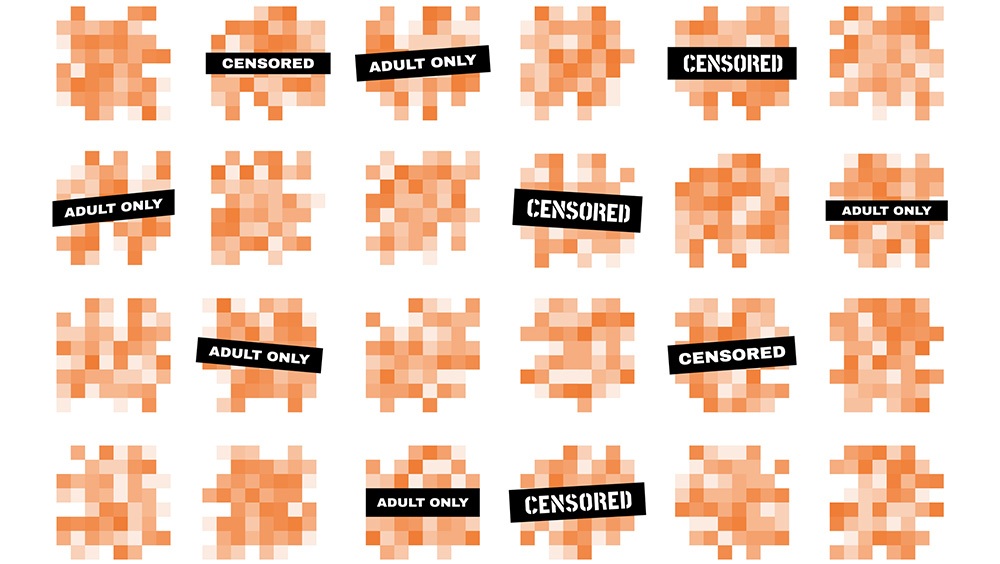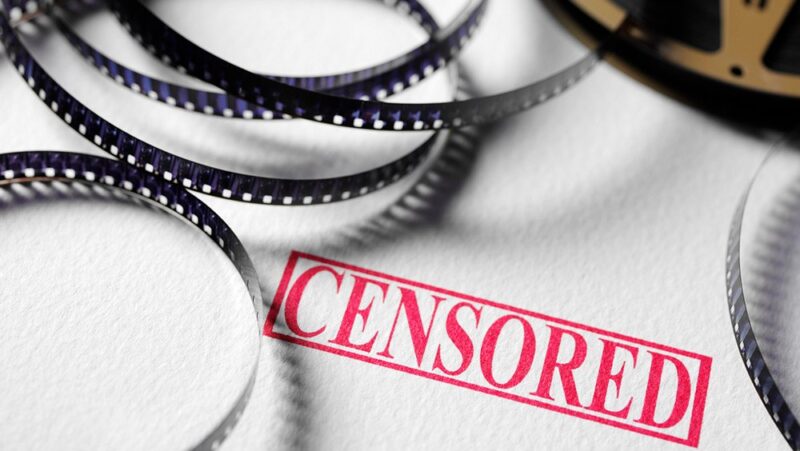Is Obscenity Protected by the First Amendment?

Free speech is the most recognized of the five First Amendment freedoms, but that doesn't mean there isn't confusion about what it protects — and when. Case in point: obscenity. Is obscenity protected by the First Amendment? Are there any exceptions? We answer all of that, and much more, in this guide.
Is obscenity protected by the First Amendment?
In short, no. Obscenity is a very narrow category of sexually explicit expression that the U.S. Supreme Court has ruled is not protected by the First Amendment. Obscene material ― usually videos, though expression can take many different forms ― deals with a shameful or morbid interest in sex, depicts sexual matter in a patently offensive way, and has no serious literary, artistic, political or scientific value.
It’s easy to confuse the legal category of obscenity with the typical dictionary definition of obscene. In everyday conversation, the typical definition of obscene is sexual material that is very offensive and disgusting, that goes beyond the typical standards of decency. But the legal definition of obscenity is different and refers to a much smaller category of material.
History of obscenity law
Historically, obscenity referred to materials that were too sacrilegious and critical of established religion. Early on, obscenity also referred to sexual materials that were simply too candid for the social norms of the time. Booksellers who sold books that contained racy passages could be prosecuted for obscenity.
Several early American courts defined material as obscene if “the tendency of the matter … is to deprave and corrupt those whose minds are open to such immoral influences, and into whose hands a publication of this sort may fall.”
This test for obscenity, adopted from the British decision Regina v. Hicklin (1868), was not very protective of free speech for two reasons.
First, it allowed material to be deemed obscene based on isolated passages of a work rather than considering the work as a whole. For example, a book could be declared obscene based on one graphic, frank description of sexual activity under this restrictive test.
Second, the test focused on the most susceptible people and reduced everyone’s access to the speech for the sake of protecting the least permissive people’s taste. This explains why the Hicklin test led to the suppression of even some mainstream literature, such as works by D.H. Lawrence or James Joyce, as legally obscene.
The Supreme Court adopted a different test in Roth v. United States (1957). Samuel Roth ran a publishing business that included books that contained nude pictures and sexual themes. Roth was charged with violating a federal obscenity law for mailing obscene materials. Convicted by a jury, Roth and his attorneys appealed his case all the way to the Supreme Court. The court upheld his conviction, writing that “obscenity is not within the area of constitutionally protected speech or press.” The court created the following test for obscenity: “whether to the average person, applying contemporary community standards, the dominant theme of the material taken as a whole appeals to the prurient interest.” In a footnote, the court defined “prurient” interest as “material having a tendency to excite lustful thoughts” and “having morbid or lascivious longings.”
However, the Supreme Court and lower courts had massive trouble using this definition to determine exactly where the line was between protected speech and unprotected obscenity. Justice Potter Stewart famously opined in Jacobellis v. Ohio (1964): “I shall not today attempt further to define [obscenity] ... and perhaps I could never succeed in intelligibly doing so. But I know it when I see it, and the motion picture involved in this case is not that.”
The Miller test: How courts define obscenity today
The court embraced a different test for obscenity, which is the standard used today, in Miller v. California (1973). Under the so-called Miller test, material is obscene if it meets all three of these components:
- The average person, applying contemporary community standards, would find that the work, taken as a whole, appeals to the prurient interest. This means that the material must appeal to a morbid interest in sex as opposed to a healthy interest in sex. Materials that have some sexually therapeutic value would not qualify as prurient.
- The work depicts or describes, in a patently offensive way, sexual conduct specifically defined by the applicable state law. This means that the depictions of sexual activity must be really graphic and beyond customary limits of candor. For example, pictures of sexual activity in a medical textbook would not qualify as patently offensive.
- The work, taken as a whole, lacks serious literary, artistic, political or scientific value. This ensures that material with serious value is not misclassified as obscene. For example, someone may not like the profane lyrics of a song, but the music may well have serious value and could not reasonably be considered obscene.
Marvin Miller, who owned a mail-order pornography business, argued that there needed to be a national standard for obscenity, or else a publisher or distributor of sexual materials could be punished in the most conservative community. But Justice Warren Burger disagreed, writing: “It is neither realistic nor constitutionally sound to read the First Amendment as requiring that the people of Maine or Mississippi accept public depiction of conduct found tolerable in Las Vegas or New York City.”
The court reaffirmed that:
- Obscenity is not protected by the First Amendment.
- States can regulate obscenity without showing that the material is “utterly without redeeming social value.”
- Obscenity is to be determined by contemporary community standards, not a national standard.
The Miller test remains the dominant test in obscenity law to this day. In fact, nearly all state obscenity laws are modeled after its requirements. However, a serious question remains as to whether state obscenity laws make sense when sexual material is disseminated online nationally, if not globally.
Music is not legally obscene
An important limitation on obscenity law is that the material must lack serious literary, artistic, political or scientific value to be legally obscene. Some call this the SLAPS provision. Consider the example from Florida involving Sheriff Nick Navarro, who sought to have the music of the rap group 2 Live Crew declared obscene.
A federal district court determined — after hearing the group’s album “As Nasty as They Wanna Be” — that it was obscene. But on appeal, the 11th U.S. Circuit Court of Appeals cited the testimony of four expert witnesses – including music critics and a professor of African American studies – to say that the material had serious artistic value, so it wasn’t obscene. The court’s decision in Luke Records v. Navarro (11th Cir., 1992) stands for the principle that music rarely, if ever, can be considered legally obscene.
Violent entertainment is not obscene
The Supreme Court has resisted efforts to extend the concept of obscenity from sex to violence. California argued that violence could be obscene in defending its 2005 law regulating the sale or rental of violent video games to minors. The court invalidated the California law and explained in Brown v. Entertainment Merchants Association (2011) that “violence is not part of the obscenity that the Constitution permits to be regulated.”
Can books be obscene?
Some efforts to limit access to certain books in public schools are based on the idea that these books are harmful to minors or obscene when it comes to minors. Most books do not technically qualify as obscenity under the definition established in Miller v. California (1973). However, some argue that certain books are unacceptable or unsuitable for minors or at least for younger children. The Supreme Court agreed that obscenity can be variable based on the audience in Ginsberg v. New York (1968). In that case, it upheld a New York law that limited the sale of certain sexually explicit material to minors. But it’s unlikely that any school would consider material that would meet such an obscenity standard geared toward minors as educationally appropriate for school use.
Obscenity and the First Amendment: The bottom line
Obscenity remains a controversial area of the First Amendment, as many wonder exactly where to draw the line between protected and unprotected speech when it comes to sexual materials. Critics contend that obscenity is too much in the eye of the beholder. In other words, jurors in one community may view material much differently than jurors in another community. Does it make sense to rely on “contemporary community standards” when material is readily available online and accessible from any location? And as Justice John Marshall Harlan II famously wrote in the profanity case Cohen v. California (1971), “one man’s vulgarity is another’s lyric.”
David L. Hudson Jr. is a First Amendment fellow for the Freedom Forum and a law professor at Belmont University who publishes widely on First Amendment topics and is the author of several First Amendment books.
Banned Movies: 20+ Films That Were Censored or Restricted
Election Night 2024 Through the Lens: Press Capture Historic Event
Related Content

